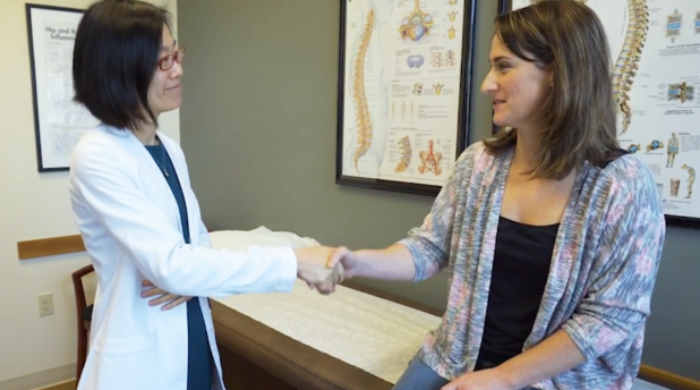When you get injured, your first thought may be to make an appointment directly with an orthopedic surgeon, chiropractor, or sports medicine physician. But these are not your only options; there is a relatively new discipline that helps a wide range of patients, including those suffering from injury, disease, or musculoskeletal pain. This type of physician is called a physiatrist.
Physiatrists provide secondary prevention of disability, take a non-surgical approach to rehabilitation, and are dedicated to problems of the musculoskeletal system. Consulting with a physiatrist before seeking surgical treatment can be a valuable decision. Physiatrists offer big-picture insight to help patients understand their full spectrum of treatment options.
Physiatrists work in many different settings such as inpatient rehabilitation, outpatient clinics, and pediatric clinics. At WWMG, we have physiatrists on staff in several departments.
What is a Physiatrist?
A ‘physiatrist’ is a physician who specializes in Physical Medicine and Rehabilitation. A physiatrist is a highly trained medical professional who focuses on whole body treatment for the musculoskeletal system and its pain-causing disorders. A physiatrist diagnoses, manages, and treats pain from injury, illness, or medical conditions, predominantly using physical means for recovery such as physical therapy and medicine. The goal of a physiatrist is to help patients recover their functional wellbeing and to return to a healthy and functional life.
Role of a Physiatrist
Physiatrists study the big picture. Their training is broad, and allows them to look at the total body, rather than just one organ. By considering other areas of the body, physiatrists can be helpful for pinpointing difficult-to-diagnose pain by examining the relationships of all the moving parts of the body. A physiatrist’s goal is to restore functionality in patients living with injuries, diseases, and disorders.
Physiatrists often act as a consultant to physicians, such as primary care physicians and neurologists, or lead a team of medical professionals to optimize a patient’s treatment. When a physiatrist takes a central role in your rehabilitation, they will do everything, from creating your step-by-step plan for rehabilitation, to directing your whole rehabilitation team, enlisting the support of several experts such as physical therapists, occupational therapists, psychologists, care managers, and other physicians and professionals.
Physiatrists can use nonsurgical procedures to treat injury and illness, and manage pain. This can involve prescribing adjuvant and analgesic medications to help with function recovery, strength and flexibility exercises, and aids such as braces and wheelchairs. For those needing surgical procedures, consulting a physiatrist before and after surgery can be can be very helpful in speeding up recovery and maintain functionality.
Because a physiatrist focuses on functional wellness, they tailor your treatment to your needs. If you simply want to climb the stairs or be able to play on the floor with your children, your treatment program may be different than an injured Olympic athlete hoping to compete professionally again. Whatever your needs, a physiatrist can help get you there. Physiatrists will:
- Clarify the value and role of physical therapy in your treatment, instructing patients on proper exercise techniques.
- Design a personalized physical therapy regimen.
- Act as a health and nutrition counselor to help patients develop healthy habits.
- Prescribe and manage medication.
- Administer injections to a patient’s pain areas to help relieve pain and restore function.
- Enlist psychosocial support, and the support of other medical professionals.
- Prescribe complementary therapies, such as medical acupuncture.
If a patient doesn’t respond positively to nonsurgical treatment, a physiatrist may refer patients to a surgical specialist.
Training
Physiatrists complete training needed to treat a variety of medical conditions that affect the musculoskeletal system, including the brain, spinal cord, nerves, bones, joints, ligaments, muscles, and tendons.
Training includes an undergraduate degree, four years of medical school, and four years of residency. After residency, physiatrists may elect to specialize. In this case, physiatrists will complete a fellowship in a specific area. Some options are listed below.
In the following specialties, a physician will learn to:
- Rehabilitate the spine after injury. Because back pain is a common ailment, many physiatrists choose to specialize in treating the spine. They may focus more on rehabilitation of the spine or spinal pain management.
- Treat chronic musculoskeletal pain and learn to prescribe medicines and physical therapy for pain main management.
- Rehabilitate after sports injuries.
- Restore function of the brain after stroke or injury. Physicians will assess and prescribe treatment for patients, attending to changes such as poor memory, impulsivity, and communication disabilities.
- Rehabilitate the nerves and function of the spinal cord.
- Specialize in treating patients under the age of 18.
What Procedures do Physiatrists Perform?
As mentioned above, Physiatrists perform non-surgical procedures. These procedures may include:
- Electromyography (EMG): Inserting fine needle electrodes into muscles to measure the performance of muscles and nerves. This helps physiatrists discern if weakness is due to dysfunction of the muscles or nerves.
- Nerve conduction studies (NCS): Using electrodes to establish the location of a nervous system injury.
- Peripheral joint injections: Injecting bone and soft tissues to help diagnose and treat disorders.
- Trigger point injections: Using lidocaine or dry needling on trigger points to ease soft tissue pain.
- Musculoskeletal ultrasound: Using internal imagery through an ultrasound to evaluate soft tissue abnormalities, and to guide injections.
- Spasticity management: Using oral antispasticity agents to treat spasticity after CNS injury (stroke, cerebral palsy, etc.), and to help relieve pain.
- Physiatrists may also provide treatments such as image-guided spinal diagnostics and injections, epidural injections, radiofrequency ablation, and other procedures such as acupuncture, and stem cell treatments.
If you or someone you know is suffering from musculoskeletal pain, injury, or disease, talk to your physician about being referred to a WWMG physiatrist. We strive to be a model physiatry practice through continual education, and dedication to providing quality care.
